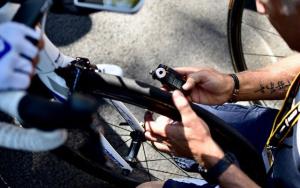The Tour de France cycling race around France is increasingly full of technology, from super aerodynamic frames, ultralight tires, oval chains, slippery costumes, to chains that are made sprinkle powder.
Racing teams will try all kinds of methods to be able to run faster. So it’s exciting to see a change of “traditional” take place in the technologically advanced world of cycling. We are talking about tires that are getting bigger and bigger with the pressure decreasing day by day.

The tires are getting bigger and bigger with the pressure decreasing day by day.
This is a new trend emerging at the Tour de France, and it has significant advantages: making the car faster and more comfortable in the harsh real-world conditions.
This tire has been studied by many experts, the most prominent of which is the study published by VeloNews. It’s also a slap in the face of the conventional wisdom that you’ll go faster if you use narrower widths and higher pressures.

These are the tires of Greg Van Avermaet, the reigning Olympic champion who leads multiple laps of the Tour de France. It measures 26mm compared to the traditional 23mm size.
Last week, at the Tour de France, Geoff Brown, head of mechanical engineering for the EF Education First-Drapac p/b Cannondale team, shared some insight into the trend.
When asked about the trend of big tires and low pressure – something that used to be the complete opposite of what professional cyclists think, but has now become a must-have standard for top racing teams, he said:
“It depends on the surface of the track, but 10 years ago the standard was a 23mm tire with a pressure of 8 or 8.5 bar, or 115, 120 psi. Today, when racing normally, the tire is 25mm and has a pressure of 7. up to 7.5 bar for both front and rear wheels, which is slightly below the 100-110 maximum on bicycles.
So what advantage does it have?
“There’s a lot of real science in racing these days,” explains Brown . “A lower-pressure tire, with more contact surface, will result in lower drag, which is inherently lower in drag. is one of the main elements in racing.
Bicycles are getting stiffer by the day, with carbon-fiber frames, especially aerodynamic frames and even aerodynamic tires – everything is stiffer, so lower pressure helps with mobility. members feel more comfortable.”

Taylor Phinney’s tires for the Roubaix stage of the 2018 race, with a size of 30mm, are extremely suitable for farm roads in the North of France.
It is a fact that in 2018, we have not seen a single 23mm tire. As of now, the most popular tire sizes are 25mm and 26mm.
And while it’s difficult to compare race speeds based on tire width and pressure, studies and the growing number of teams using these tires say it all.
Will we soon see 27mm or 28mm tires at the Tour de France in the near future?
“Things are changing very quickly in this sport,” said Brown. “The disc brakes have really gained momentum now, so with those chassis you can definitely use big tires because that’s what’s going on.” case allowed.
I predict the tire size will increase to 26mm or 27mm and become the standard tire for racing. Sure. Why not?”
Even big riders – like Taylor Phinney, 1.98 meters tall, 85kg – use low-pressure tires like small, light mountain climbers like Rigoberto Uran.
“In terms of tire pressure, they’re all the same because it’s a team sport, and if Phinney is driving next to Rigo and the tires are worn out, he needs a new tire right away,” Brown said . All are prepared to revolve around the leader, if he uses 7 bar tires, the whole team has to use 7 bar tires.

